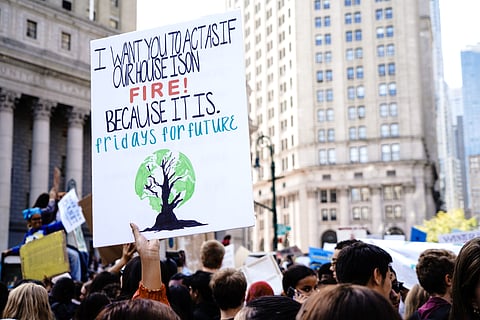
- Home
- न्यूजग्राम
- India
- World
- Politics
- Entertainment
- Culture
- Lifestyle
- Economy
- Sports
- Sp. Coverage
- Misc.
- NewsGram Exclusive
- Jobs / Internships

Citizen engagement initiatives are becoming increasingly popular as a way to influence public policy decisions. This includes anything from grassroots campaigns, online petitions and voter mobilisation efforts. (Katie Rodriguez / Unsplash)
A Guide to Influencing Public Policy
By: Shreya Jain
In a rapidly changing world, it’s essential to understand that many of the decisions made by governments regarding policy are usually influenced in some way, shape or form. The public, lobby groups and other groups use various tactics to influence these decisions – from utilising creative techniques ranging from citizen engagement initiatives to data-driven tactics.
In this blog post, we will outline public policy and its influences. We will also go through some ways to most effectively influence public policy decisions that shape society today as we prepare for 2023 and beyond.
Public policy is a set of laws, regulations and programs put in place by the government to direct public activity and ensure that citizens are informed and have access to necessary resources. It involves implementing laws or regulations to promote society's general welfare and solve public problems. Professionals study courses such as the master’s of public policy for background and a career path.
There are a variety of influences that shape public policy, such as citizens, political leaders and special interest groups. Citizens influence public policy by participating in elections, voicing their opinion on social media, contributing to public discourse or through political movements. Political leaders may influence public decisions by introducing bills or pushing for policy changes. Special interest groups can also shape public policy by advocating for specific issues and lobbying decision-makers to address their concerns.
Citizen engagement initiatives are becoming increasingly popular as a way to influence public policy decisions. This includes anything from grassroots campaigns, online petitions and voter mobilisation efforts. Such initiatives typically involve citizens who come together to express their views on issues they care about and demand action from decision-makers. Popular citizen engagement initiatives include marches, rallies, protests or demonstrations.
Data-driven tactics are also becoming increasingly popular in influencing public policy decisions. This includes collecting, analysing and interpreting data to understand trends or identify areas of improvement that could be addressed through policy changes. Data-driven initiatives may also involve creating models representing citizens' best interests, such as the cost-benefit analysis used to analyse the costs and benefits of different policy options.
Social media is an incredibly powerful tool for influencing public policy. It allows people to quickly and effectively spread their message, engage with decision-makers and raise awareness on issues of concern.
By utilising social media platforms such as Twitter, Instagram or Facebook, citizens can create content that raises awareness on specific topics and encourages others to join the conversation. Additionally, social media can be used to target decision-makers and put pressure on them to address the issues at hand.
In addition to citizens engaging directly with policymakers, a variety of lobby groups and other advocacy organisations can influence public policy.
These organisations typically specialise in a specific area, such as environmental protection or human rights, and work to influence public opinion and politicians on the issue. By connecting with these organisations, citizens can leverage their expertise and amplify their message to reach a wider audience.
Writing letters and petitions to local politicians is becoming increasingly popular in influencing public policy decisions. By submitting a letter or petition to a politician, citizens can raise their voices and make their opinions heard legally and effectively.
Letters and petitions can draw attention to specific issues, pressure decision-makers, or advocate for specific policy changes. Additionally, it gives citizens a platform to share their stories and experiences to explain better the impact of proposed or existing policies on their lives.
Another way to influence public policy decisions is by directly engaging with the decision-makers themselves. This includes attending public meetings, participating in debates, or visiting politicians.
By engaging directly with decision-makers, citizens can voice their opinions and argue why a particular policy should be adopted or amended. Additionally, it allows citizens to have an open dialogue with political representatives so they can better understand the pros and cons of various policies
Moving forward, the ways that we communicate and influence policy has been changing due to technology. While traditional methods such as grassroots campaigns and protests still happen, we notice that more discourse tends to happen in the digital landscape. If you’re interested in the influence of public policy, then it's worth looking at these avenues for the future.
